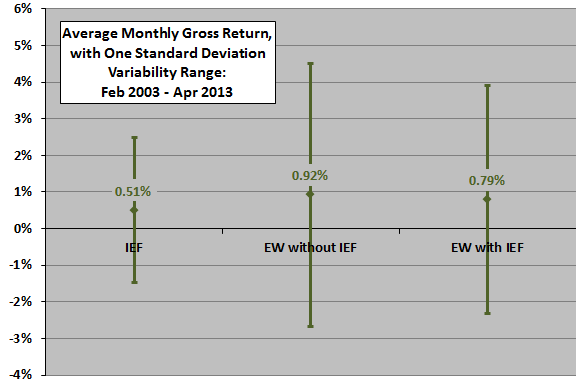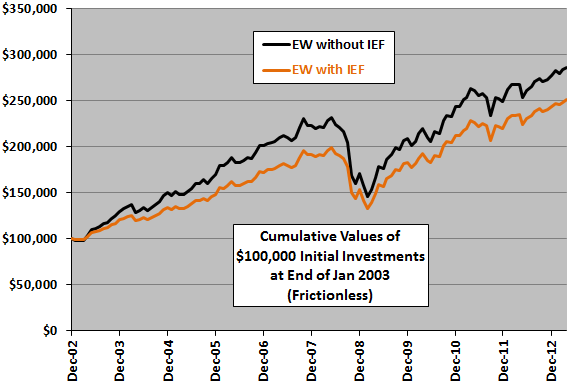It is plausible that crude oil as a dominant energy commodity has return characteristics substantially different from those of other commodities and asset classes, and therefore represent a good diversification opprotunity. To check, we add iShares Barclays 7-10 Year Treasury (IEF) to the following mix of asset class proxies (the same used in “Simple Asset Class ETF Momentum Strategy”):
PowerShares DB Commodity Index Tracking (DBC)
iShares MSCI Emerging Markets Index (EEM)
iShares MSCI EAFE Index (EFA)
SPDR Gold Shares (GLD)
iShares Russell 1000 Index (IWB)
iShares Russell 2000 Index (IWM)
SPDR Dow Jones REIT (RWR)
iShares Barclays 20+ Year Treasury Bond (TLT)
3-month Treasury bills (Cash)
First, per the findings of “Asset Class Diversification Effectiveness Factors”, we measure the average monthly return for IEF and the average pairwise correlation of IEF monthly returns with the monthly returns of the above assets. Then, we compare cumulative returns and basic monthly return statistics for equally weighted (EW), monthly rebalanced portfolios with and without IEF. We ignore rebalancing frictions, which would be about the same for the alternative portfolios. Using adjusted monthly returns for IEF and the above nine asset class proxies as available from January 2003 (the start of the “Simple Asset Class ETF Strategy”) through April 2013 (124 monthly returns), we find that:
The following chart summarizes average monthly returns with variability ranges of one standard deviation for IEF and the EW portfolios without and with IEF over the available sample period. During this time, IEF generates a weak average return and high volatility compared to EW without IEF. Adding IEF to the diversified EW portfolio marginally reduces return and increases volatility. The ratio of average return to standard deviation (return per unit of risk) is 0.26 (0.25) without (with) a IEF position.
The average pairwise correlation of IEF monthly returns with those of the other assets is a low -0.03 over the available sample period. Correlation with TLT is an understandably high 0.90.
Per “Asset Class Diversification Effectiveness Factors,” the somewhat low average return (low average pairwise correlation) of IEF indicates a marginal (good) contribution with respect to portfolio diversification.
Sample size is not large in terms of a variety of market conditions.
What is the net result of these effects?

The next chart compares cumulative values of EW portfolios without and with IEF in the mix over the available sample period. Adding IEF has a mostly negative effect.
Again, sample size is not large.

In summary, evidence from simple tests does not support belief that adding a proxy for mid-term U.S. Treasury notes to a diversified portfolio (including a long-term U.S. Treasury bonds proxy) improves performance.
Cautions regarding findings include:
- As noted, the sample period is very short in terms of market conditions (one bear market and little variation in base interest rates).
- Including the trading frictions associated with monthly rebalancing would depress performance of both portfolios, depending mostly on portfolio size.